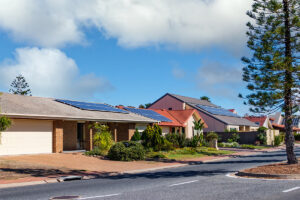- According to a Tony Wood from the Grattan Institute, Too much solar power produced in off-peak periods may cause grid issues, depress wholesale prices and lead retailers to reduce Feed in tariff amounts.
- Others, such as research firm Green Energy Markets say it’s not currently a serious issue and one that can be solved relatively simply if it does become a problem in the next decade through increase battery storage and usage of hot water systems in low peak times to soak up solar power production.
- Wholesale prices falling because of solar energy is a good thing and not a ‘problem’.
- A solar power rooftop system continues to be good investment for a household even if Feed in tariffs are reduce going forward but there is increasing pressure on the government to reduce the rebate which pays for around 40% of system installation costs. This means that there is a chance that the rebate may be reduced this year.
Last year 3.5 million solar panels were installed on Australian rooftops and 1 in 5 households saved money on their power bills by selling electricity back to the grid, so surely producing a lot of solar power is good?
Not according to Grattan Institute, an independent Australian public policy think tank. The Grattan Institute’s Energy Program Director Tony Wood is concerned that too much solar power from small-scale solar systems will cause grid instability, depress wholesale prices and reduce FITs (feed-in tariffs).
Wood is worried that there is too much solar power being produced in the middle of the day, a period of low demand. At certain times there will be too much electricity, he says, and it will lose its value. The government may stop deciding to pay for electricity that isn’t needed, and that wouldn’t be good for people who have put in solar and are paying off their system.
But Green Energy Markets’ Tristan Edis says the over-supply to the grid isn’t a serious issue and pretty marginal at the moment. While he does agree it will need to be addressed within the next 10 years, it’s not a problem currently. “Right now the penetration of solar on a very good day in South Australia may reach 30% of total demand”.
Plus he thinks there are simple solutions to absorbing high levels of solar power produced during the day. One of these is the installation of battery storage, for times of high demand, which is becoming more on people’s radar as cost of battery systems fall. Edis says that by the time grid power becomes a problem for grid operations battery storage will be a “reasonably affordable and an attractive investment to soak up that generation [of solar power].”
Another is for households to programme their hot water systems to come on during the middle of the day instead of in the morning and evening to mop up any ‘excess’ solar production. This should provide more stability for grid operators and the majority of modern hot water systems, are designed to do this.
Addressing the issue of FITs falling, Edis argues that even if wholesale prices go down by a few cents, a solar power rooftop system continues to be good investment for a household. Even for those who have paid cash or increased their mortgage to install solar “There are miles to go before those people are underwater because of their solar investment,” says Edis.
Even if the price of FITs decline slightly in the coming years, solar is a clean energy source for now and for the future that is filling the gap left by aging coal-generators that continue to be closed down. The overall reduction in wholesale prices for electricity consumers Australia-wide should be seen as a positive and something to celebrate, says Edis, not something that is a ‘problem’.
Source: PV Magazine
Related articles
https://www.solarmarket.com.au/blog/future-energy-grid
https://www.solarmarket.com.au/winners-losers-teslas-battery-plan-for-home/
https://www.solarmarket.com.au/learn/current-rebates/










